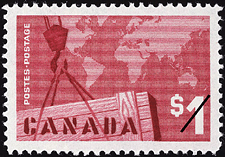Export Trade - 1 dollar 1963 - Canadian stamp
Specifications
- Quantity: 19 360 000
- Issue date: June 14, 1963
- Printer: Canadian Bank Note Company, Limited
- Perforation: 12
- Scott: #411
Export Trade - 1 dollar 1963 prices and values
The value of a Export Trade - 1 dollar 1963 stamp depends on several factors such as quality and wear, supply and demand, rarity, finish and more. Values in the section are based on the market, trends, auctions and recognized books, publications and catalogs. This section also includes information on errors and varieties and characteristics.

- Used
- Mint
- With gum - Never Hinged
| VG | F | VF | Cover | |
|---|---|---|---|---|
| Export Trade - 1 dollar 1963 | $0.31 | $0.62 | $1.20 | $6.10 |
| VG | F | VF | |
|---|---|---|---|
| Export Trade - 1 dollar 1963 | $1.60 | $2.10 | $3.20 |
| VG | F | VF | |
|---|---|---|---|
| Export Trade - 1 dollar 1963 | $3.20 | $4.20 | $6.30 |
Description
From the earliest days Canada has been a trading nation. The development of this country was undertaken, in large part, because of its commercial potential in the fur trade. Canada has grown and prospered in the last 350 years and while the trade products are more diversified, reliance on trade has not diminished. Before the Second World War, and to some extent since then, exports from Canada have been largely agricultural goods and raw materials. There has, however, been an increasing emphasis on manufactured goods and products of secondary industry. A large proportion of these goods have been sent to the United States, with a smaller proportion going to Europe, South America, and to the Orient. Since a large part of the national income and major portions of the revenues of many important industries are derived from foreign trade, developments in principal world markets are of direct interest to Canada's economy.
The expansion of such groups as the European Economic Community and the European Free Trade Association have treatly affected the traditional trading ties of Canada and have required many adjustments to the changing world economic climate. Canada and the United States joined eighteen European countries to form the Organization for European Co-operation and Development (OECD) which was set up in December 1960. The main objectives of the OECD are to encourage economic and financial growth among member countries, to contribute to the sound expansion of the underdeveloped nations, and to work for an increase in world trade on a multilateral and nondiscriminatory basis. Although Canada's volume of trade, on a per capita basis, has declined considerably , dropping from second place in 1957 and 1958, to third in 1959, and eighth in 1960 and 1961, her position relative to total world trade has remained virtually unchanged during that time with only a slight drop from fourth to fifth position. With the increase in trade markets and the rapidly growing production capacity of nations, the buyers of the world are now able to be more selective and the exporter must constantly work to improve his products.
Creators
Designed by Alan L. Pollock
Picture engraved by Yves Baril
Lettering engraved by Donald J. Mitchell
Right now on Ebay (Ad)
Stampsandcanada.com is supported by its audience. When you buy through links on our site, we may earn a commission.
Note
The values on this page are in Canadian dollars (CAD).

